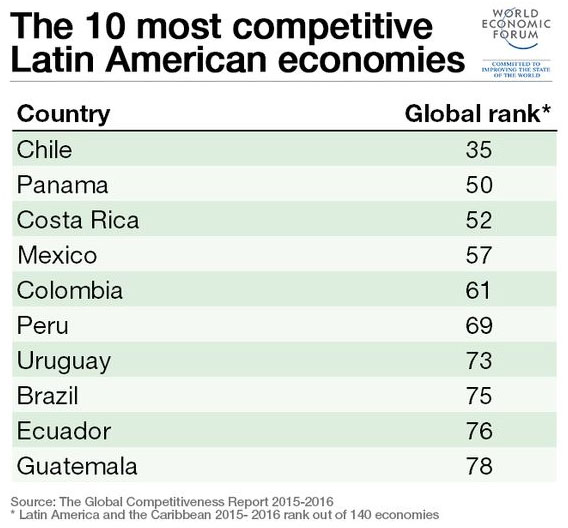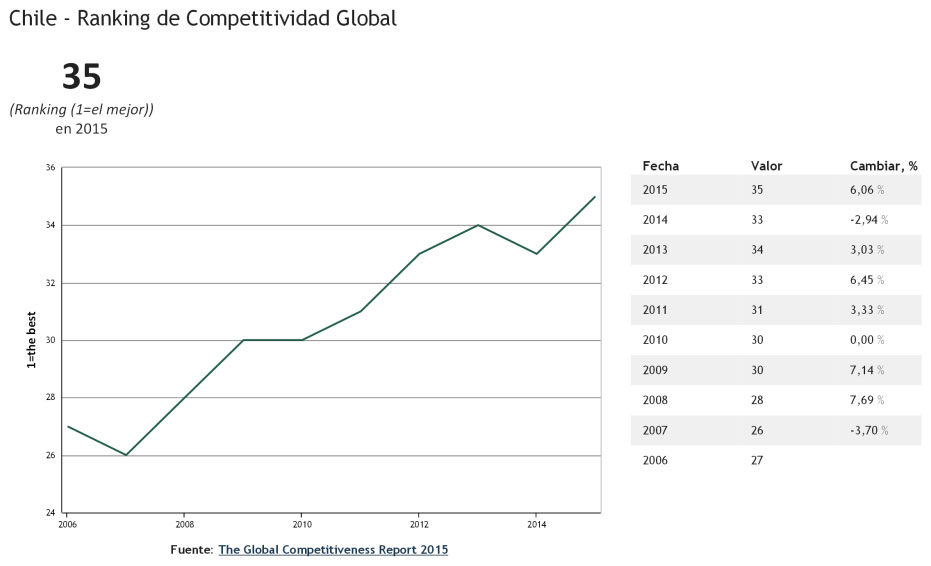Achilles' heel: productivity

By Soledad Soza
Source: https://www.academia.edu/22153397/TOP_5_RISKS_AND_OPPORTUNITIES_CHILE_2016
What does it take to jump to hit development?
WEF’s country report 2015 / 2016 puts Chile in the 35th position in the competitiveness ranking worldwide (140 countries). Even though Chile is 2 positions below in the ranking compared to 2014, Chile still leads in the Latin American region. This is due to variables such as “solid institutions (32nd), a stable macroeconomic environment (29th), well-functioning financial markets (21st), high technological readiness (39th), and widespread uptake of ICTs (47th)”.

WEF’s country report puts Chile on a transition to development, along with 19 other countries. Therefore, the question would be: what does Chile need to jump into full development?
According to WEF, the emphasis should be on innovation drivers, hence problematic factors impeding to jump from transition are related to “long-standing issues such as its education system, specifically the overall quality of primary education (108th) and math and science education (107th). Higher education and training is in much better shape (33rd), but Chile must do more to improve its capacity to innovate (85th) in areas such as R&D (92nd) to diversify and foster robust growth”.
According to WEF definition, competitiveness is the set of institutions, policies, and factors that determine the level of productivity of a country, hence the emphasis on productivity is key to understand the country’s prosperity. Therefore, higher productivity translates into competitiveness, which, by definition, is the pace at which countries continue to perform in a given period regardless of external pressures or forces.

The competitive edge Chile needs to pull is connected with the mechanisms by which the country can invigorate its educational system. Not only equity-related but, most importantly, quality-driven. According to the WEF country report, 2015/2016, the most negative variables for doing business in Chile are a) an inadequately educated workforce and b) insufficient capacity to innovate. For 25 years, China’s demand for raw materials, particularly Chilean copper, clouded any critical view on poor educational variables. Those measures were given to authorities as warning signs by WEF in previous reports. Still, concerns over education performance did not materialize in public policy until the end of a political cycle that culminated in social mobilization by 2011 to demand an end to “disparities” (OECD Country Report 2013, 2014, 2015). For 25 years, Chile focused on macroeconomics to hit growth targets. The strategic significance of educational variables did not surface in the political landscape during the 25-30-year political cycle that gave Chile governance and stability. In a new electoral cycle (2013) demands from students’ leaders were incorporated in the power sphere. The Government presented a second-generation reform on education and tax reform to support it. Second-generation reforms have emerged as the necessary tool to bring Chile into “inclusive growth” (OECD Country Report 2012, 2013, 2014, 2015) and have been deemed strategic by international organizations where Chile is a fully-fledged member (OECD, IMF, WB). As a result, new legislation is underway to reinvigorate the teaching profession, penalize profit and discriminatory enrollment at the school, and warrant free tertiary education to pre-graduate students from the lowest socio-economic quintiles in society. It is expected that by introducing policies aiming at inclusive growth, Chile may overcome the great disparities observed by the OECD. However, there is much homework about quality standards and the necessary synergies between private companies and educational bodies toward skills and productivity to reach the global added value chain. Universities play a fundamental role, and new legislation must press hard on high-quality standards and public-private initiatives on R&D. More governmental investment must be invested in investigation projects. Chile is transitioning to a knowledge-based society and faces the challenge of overcoming the middle-income trap” whereby countries get stuck by an extractive economy without any room for value-added products due to poor innovation.
According to the WEF country report 2015 /2016, “Chile must do more to improve its capacity to innovate (85th) in areas such as R&D (92nd) to diversify and foster robust growth”.
Over the next 2 remaining years, Bachelet’s government will be tested on the institutional ability to produce efficient public policies. Technological development in Chile is on the right track. According to the WEF IT Report 2015, Chile leads in ICTs in Latin America and the Caribbean.
RISK:
Extractive economies run the risk of overconfidence in their exports of raw materials. Overconfidence in copper exports may cloud the long-term vision of value-added products, a more diversified matrix, and the strategic importance of innovation. R&D is key to shielding an open economy like Chile from external shocks and the geopolitics of China’s slowdown. Inclusive growth without attention to high-quality standards in education cannot solve the issue of poor educational variables per se. More is needed on primary education and investment in R&D. Greater incentives are needed to boost public-private synergies on technology, patents, and research. Greater incentives for universities to create research centers are required. It is necessary to align all actors around innovation-driven factors to hit development targets and overcome the “middle-income trap” threat in extractive economies.
OPPORTUNITY:
Against the backdrop of economic slowdown, a fall in copper prices, and an appreciated dollar, Chile has an opportunity to design efficient policies to improve its educational system, namely to create a better-educated workforce able to innovate. Opportunity to legislate on high-quality standards at the tertiary level. Opportunity to reform education at the primary level, especially for low-income families. Opportunity to align all actors (entrepreneurs, politicians, and civil society) on a common goal with a long-term vision to hit development targets. Opportunity to overcome “disparities” observed in the economic model (OECD, Country Report 2013, 2014, 2015). Opportunity to legitimize second-generation reforms as necessary tools to jump into full development through higher productivity.
